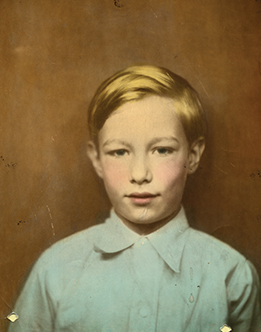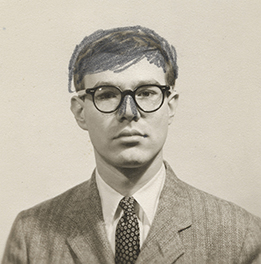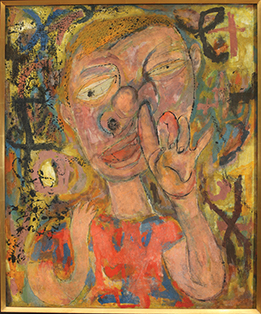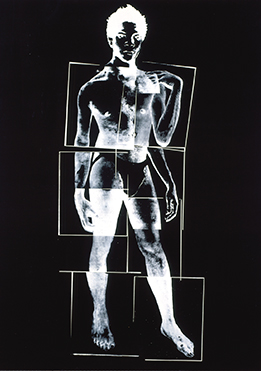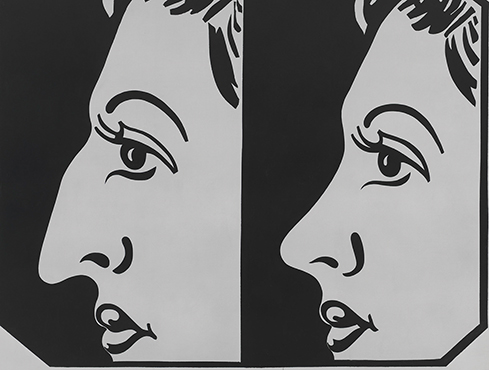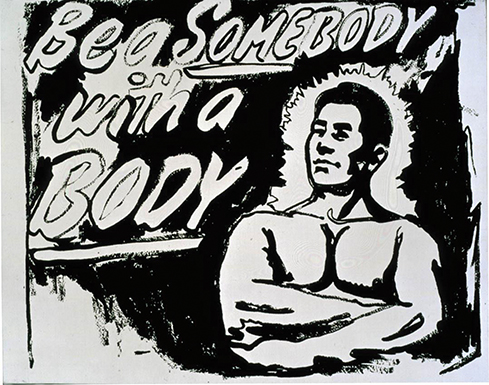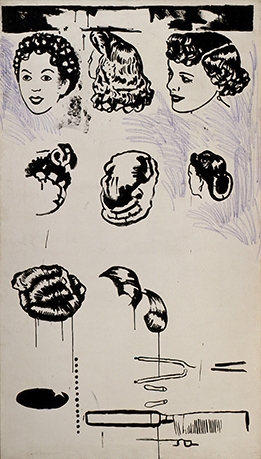 |
||||||||||||||||||||||
Edward Wallowitch, Andy Warhol with Face in Hands, 1957–58, The Andy Warhol Museum; Founding Collection, Contribution The Andy Warhol Foundation for the Visual Arts, Inc., © 2016 Edward Wallowitch Estate |
My Perfect, Imperfect Body
Andy Warhol loved the beauty in others but couldn’t see it in himself. A new exhibition shows how the artist’s insecurities about his appearance transformed his art. Andy Warhol stepped out of the shower, and his friend John Giorno gaped. It was 1963, and something rare had just occurred: The artist allowed himself to be seen completely naked. Not even his trademark wig masked his bald head.
Giorno had accompanied Warhol on a trip to a mutual friend’s house in Connecticut, and was struck by Warhol’s muscles. Who knew? Usually they were hidden by jeans and a loose white shirt. But he was well toned from his 18-hour-a-day, speed-fueled artist’s workout of silkscreening and painting. Warhol never understood what Giorno saw; the artist could only see his reflection through a fun-house mirror of distortion. “He always thought he was ugly. He always thought everybody else was beautiful,” says Giorno. “He always thought everybody else’s ugly body was beautiful.” Warhol’s gnawing insecurities about his own appearance were rooted in his sickly childhood and exacerbated by premature baldness, the taboo of homosexuality, and, later, scarring from gunshot wounds. Selfconsciousness about physical imperfections is universal, but the Pop art icon took it to another level. Now, a new exhibition, Andy Warhol: My Perfect Body, will offer the first comprehensive look at Warhol’s complicated and fascinating relationship with the body. The brainchild of The Andy Warhol Museum’s Associate Curator of Art Jessica Beck, it opens at The Warhol on October 21 and runs through January 22, 2017. The show will include more than 200 paintings, drawings, and photographs that highlight the museum’s permanent collection as well as rarely traveled loans from the collections of other major American museums. Among the works: a painting of an impaled car crash victim, Christ juxtaposed against a body builder, paintings of cosmetic surgery, and a rare photograph of Warhol pumping iron. “In Warhol’s work and writing, he points out, over and over, that beauty has this close relationship to pain,” Beck notes. “His own anxieties become manifested into the work.” Warhol even presented images of the body’s interior, creating medical sketches of the human anatomy to illustrate his famous quote: “Pop is just taking the outside and putting it on the inside or taking the inside and putting it on the outside.” His art also drew from the false promise of Madison Avenue—that clothes, cosmetics, and surgeries can create the ideal beauty. “He was really thinking about people’s insecurities about their appearance and his own,” says James Boaden, assistant professor of art history at the University of York in England who writes about Warhol. “He is as important as his artwork and that’s why he was so influential. He created a certain kind of persona and the paintings were drawn off the back of him. He created the persona out of his anxieties. He wore a wig, dressed in leather jackets, and disguised the body in ways that helped him reinvent himself.” “After I check myself out in the mirror, I slip into my BVDs. Nudity is a threat to my existence.”- Andy WarholAs a kid growing up in the South Oakland neighborhood of Pittsburgh, Warhol was always self-conscious about his appearance. At age 8 he contracted Sydenham chorea, also known as St. Vitus Dance, a rare disorder of the nervous system. During his youth he also suffered from a pale, blotchy complexion that polluted his self-image.
After college, Warhol continued engaging with the idea of fixing an imperfect nose, both personally and artistically. In the early ’50s, after moving from Pittsburgh to New York to become a commercial artist, he doctored his passport photo. Using a black pencil, Warhol narrowed his nose and filled in his balding head with hair. A trip to the surgeon’s office wouldn’t measure up to his improvements on paper. At age 29, he underwent unsatisfying plastic surgery on his nose. “Warhol didn’t have true rhinoplasty where the nose is fractured and reshaped,” Beck says. “His nose issue was actually a skin issue. He had the skin shaved, a procedure which forces new skin to grow in its place. He spoke openly about his disappointment with the procedure in Popism,” even complaining that his pores looked larger afterwards. In fact, Beck says Warhol perfected his artistic style—now known as Pop art—by early experiments painting the human nose. Then came the day, now a legendary event, when Warhol painted multiple versions of two gigantic images of Coca-Cola bottles, a symbol of Americana—some abstract and one in clean, simple lines. He asked his friend Emile de Antonio his opinion, and de Antonio told him to go with the simple lines and discard the rest. In 1962, Pop art was born with those soft drink bottles. “His connection to Pop art starts with the body,” Beck says. A year before he created the Coca-Cola bottles, Warhol was doing similar experiments while painting a nose job ad that ran in the National Inquirer. In a series of four paintings titled Before and After, he created various versions—one in dribs and smears, others in half tones, and one in the clean lines that became his trademark. A pair of these early works will be on display in My Perfect Body. Up to that point, while Warhol was a highly successful commercial artist in the ’50s, his look was disheveled. “In the advertising trade, they called him Raggedy Andy,” says Boaden. “He used to wear shoes gaping at the front, with the toes poking out. If you think of the image of Mad Men, it was the complete opposite.” In the 1960s and 1970s, social changes roiled over the United States and Warhol’s celebrity status grew. He used his image to rewrite his story, and the rules of visual art. His trademark sunglasses, silver wigs, and black leather jackets created a mysterious persona.
“I never met a beauty I didn’t like.”- Andy WarholIn the ’60s, as Warhol made silkscreens of celebrities, he played with the concept of imperfection, and the inability to live up to expectations. “Marilyn Monroe’s face was not quite lined up with the color behind it,” Boaden says. “He played with imperfections in all sorts of ways—sometimes it’s very camp, photos of him in drag. Sometimes it’s very tragic, crime scene photos.” “The whole show is about ruptures. A rupture exposes something. Perhaps that something is Warhol’s shame in his own body.”
- JESSICA BECK, ASSOCIATE CURATOR, THE ANDY WARHOL MUSEUMIn his Polaroid portraits, notes Beck, Warhol often took an aggressive approach to editing. “He’d use bright lights and put heavy powder on people as a way to bleach out imperfections.” In his Death and Disaster series, which numbered some 70-odd works made in the mid-1960s, Warhol plucked images of mangled bodies from newspapers and police photo archives. “They’re not just car accidents. In one, the driver has been thrown from the vehicle and he is impaled around a lamp post,” Beck says. “It’s about the actual body trauma that goes on.” Warhol also deconstructed the body into imperfect forms. His painting of artist Jean-Michel Basquiat’s body is broken down into sections that suggest a Polaroid or an X-ray. If you look closely, you’ll also see he adds a third arm to the body. “There is always something askew with the bodies,” adds Beck. “It’s never an idolized beauty or perfect image. It’s never an Adonis. He’s always questioning or challenging that idea of perfection.” In 1978, Warhol took the idea of body abstraction one step further with his Oxidation paintings, iridescent canvases made up of copper paint and urine, which combined creates a chemical reaction that turns green over time. He laid canvases with ground copper, and when invited friends and acquaintances urinated on the canvas the uric acid reacted with the copper in the paint, developing a trace of the body with its abstract splatters. Warhol and his collaborators experimented with both pattern and coloration by using a variety of metallic background paints and by varying the maker’s fluid and food intake. Many of the artworks on view display the body in pieces, cropping it to show only sections at a time—torsos, feet, hands—which can be seen in such works as the film Sleep (1963) and the 1950s Boy Book drawings, which are about love and desire. “They’re incredibly intimate, beautiful, and with clean, elegant lines,” Beck says of the Boy Book works. “But there is also subversive desire at work in these sketches. Homosexuality in the 1950s was an illegal act. So, this sort of desire had to be hidden.” Recalls Giorno, “Being gay was a death in the art world as well as the real world. But Andy was skillful at walking the line. Everyone knew he was gay. He got away with it.” Just as the abstracted and tormented body are prominent themes of Warhol’s art, so is the sculpted body. For the show, Beck secured an Eve Arnold black-and-white photograph of Warhol in his New York studio, The Factory. It shows the artist in an unexpected pose: wearing sunglasses while lifting enormous dumbbells on a freestanding toilet. Even though Warhol enjoyed lifting weights at various times throughout his life, it’s rare to find photographs of him in the act, especially in the early ’60s. On June 3, 1968, Valerie Solanas, a radical feminist writer, entered The Factory and shot Warhol in the chest, nearly killing him. The event shook him to his core, Giorno says. Warhol described himself as “the living dead” and became cautious about anyone he invited into his social circle. His own damaged body became a novel source of inspiration for his art. Warhol became less self-conscious about exposing his body—he even had photographs taken to show his imperfections, including prominent scarring and the medical girdle he wore to support his organs post-surgery. “The surgery was botched,” Boaden says. “His body looked like Frankenstein, but he showed it off. He described a beautiful pattern on his skin. He played up how crazy he looked. He always liked horror movies.” Ironically, Warhol had painted abstracts of girdle ads earlier in his career, including one titled Where is Your Rupture? “The whole show is about ruptures,” Beck says. “A rupture exposes something. Perhaps that something is Warhol’s shame in his own body,” despite assurances from Giorno and others that he was actually beautiful. Giorno could never convince Warhol that he was attractive. “But being humble is the most powerful position,” Giorno says. “It all got inverted into the art. His self-consciousness was transforming.” Andy Warhol: My Perfect Body is generously supported by Cadillac and UPMC Health Plan.
|
|||||||||||||||||||||
Organizing Delirium · Body Boundaries · A Woman's World · LIGHTIME · President's Note · NewsWorthy · Face Time: Laura Micco · Artistic License: Making Some Noise · Travel Log · The Big Picture
 |
Copyright © 2017 CARNEGIE Magazine. All rights reserved. |

